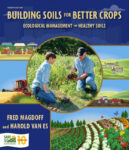The educational materials listed on this page are about Conservation Tillage.
Conservation tillage reduces soil disturbance by leaving more than thirty percent of the soil surface covered with the residue of a previous crop. This crop production system improves soil conservation, reduces soil erosion and limits water runoff. Producers can choose from several different conservation tillage systems no-till, strip-till, ridge-till or zone-till—based on their individual cropping system and on the amount of residue they want to leave on the soil surface. There is also a variety of tillage equipment available for farmers and ranchers, depending on which tillage system they use. No-till farming leaves all of the previous crop’s residue on the field. Farmers who use a strip-till system only disturb the section of soil that is necessary for seeding. Strip tillage is similar to zone tillage, but the latter cuts deeper into the soil to increase water infiltration. In ridge-till systems, farmers build raised seed beds to create a warmer seedbed with better drainage. Cover crops can be added to any conservation tillage system to provide additional residue and soil cover between cash crops.
Showing 1-1 of 1 results

Building Soils for Better Crops
The fourth edition of Building Soils for Better Crops—enhanced and expanded—explains how to use ecological principles to build soil health and boost fertility, yields and overall sustainability.